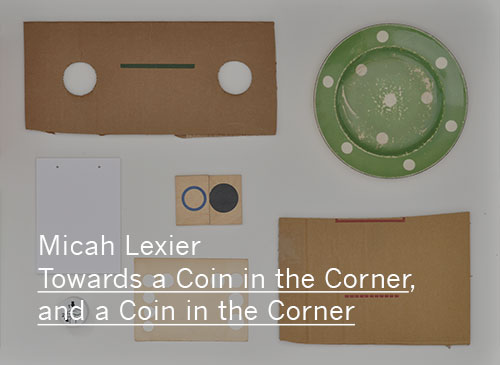Micah Lexier | Curated by John G. Hampton
March 2 – April 12, 2013
March 2 – April 12, 2013
Towards a Coin in the Corner, and a Coin in the Corner
Micah Lexier
Opening reception Saturday, March 2 at 8 PM
Curated by John G. Hampton
Limted edition Multiple available here
Towards a Coin in the Corner, and a Coin in the Corner
Placing a coin in a corner is a simple gesture; a plant; a subtle spatial intervention; an object placed right where it belongs, while also peculiarly out of place. In Micah Lexiers Towards a Coin in the Corner, and a Coin in the Corner, there are two spaces and two ways of placing a coin in a corner: one literal and one suggestive. The first, A Coin in the Corner, explores absence and the everyday through the presence of a coin; the second, Towards a Coin in the Corner, presents a formal genealogy of the first, not exhaustive, but just one collection of sympathetic elements, the whole of which conjures the coinor some other circular semblance.
A Coin in the Corner
At first glance, the first room for this exhibition appears to be empty. The bare, white walls echo the creaking of the heritage buildings aged hardwood floor as viewers enter the space. The void within provides a moment for reflection or freedom, confusion or meditation, wry mirth or annoyed disappointment, or the simple assumption that the work has not yet been installed. This sparse space evokes the spectre of that apex of minimalist practice, that single-minded, site-oriented pursuit, that architecturally bound institutional critique: the empty gallery exhibition. Yves Klein, Robert Barry, Michael Asher, Art + Language, and others have used the presentation of absence to increase our awareness of the hiddenthat which is invisible, but also that which hides in plain sight/site. The space provided by removing all apparent signifiers and sites of meaning encourages us to search for meaning in less expected places. But Lexiers emptiness is offset by a coin, the one placed in a corner of the gallery, a corner that may not have existed before. Caught from the corner of your eye, this out-of-place, unexpected, beautiful object is also quite regular, strangely at home, and curiously familiar. This simple gesture pulls us out of the gallery-as-site-of-worship, and quells expectations of genius, beauty, and grandeur, reminding us of the personal wonder of finding pleasure in a chance encounter with a found object.
Towards a Coin in the Corner
The second room contains three contiguous vitrines, tightly arranged with found objects. This display acts as an after-the-fact and speculative aesthetic genealogy for A Coin in the Corner. Its contentswhether found pieces of cardboard, a half-used sheet of red dot stickers, or an empty package for Tidley Winksall contain various allotments of circles, dashes, corners, and circles within rectangles. These elements are culled from Lexiers massive collection of found objects, plucked from whenever and wherever they are encountered. Lexiers habit of collection and display is in some ways a contemporary incarnation of the tradition of the wunderkammer (or cabinet of curiosities). As a predecessor to our modern museums, taxonomical practices, and natural sciences, the wunderkammer was a private museum organized by collectors and bricoleur scientists. Born from the same roots of modernism that gave us phrenology, the wunderkammer followed a logic of measurement and comparison, finding meaning in subtly different variations on the same form. Cassiano dal Pozzos paper museum contained thousands of drawings of natural history subjects collected to compare and contrast by shape, size, and colour; Christopher Columbuss son Ferdinand amassed an enormous print collection that was catalogued first by size, then by the number and position of figures. Lexiers collection is similarly exhaustive and arranged, but rather than amassing trophies of imperial conquest, he has found his artifacts throughout the everyday explorations we all partake in: walking to the local coffee shop or rummaging through a neighbours garage sale.
The Coin
In the corner we find a coin, and on the coin we find a corner. Minted on the face of Lexiers coin is a simple line drawing that functions as a logo for, or diagram of, a coin placed in a corner. One could imagine that this coin on a coin could have yet another coin in yet another cornernested coins in recursive cornersan aesthetic of similarity reflected mise en abyme. The coins self-referentiality points back to its singular presence in the room, recalling past encounters with other coins or similar discoveries. Moments like these form the basis of Lexiers practice. He draws from a communal admiration for the effortless beauty of everyday objects and perhaps stirs in us an urge to share a simple gesture of our own, planting some small wonder for another to find.


